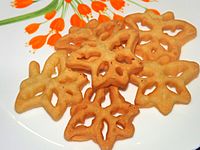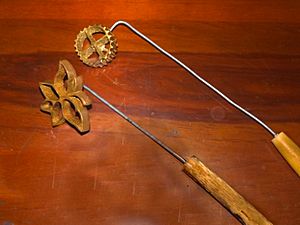Kokis facts for kids

A plate of butterfly-shaped kokis
|
|
| Type | Sweet |
|---|---|
| Course | Dessert, Appetizer |
| Place of origin | Sri Lanka/Netherlands |
| Main ingredients | Rice flour, Coconut milk |
Kokis (Sinhala: කොකිස්) is a yummy, crispy snack from Sri Lanka. It's made by deep-frying a batter of rice flour and coconut milk. Even though it's a traditional Sri Lankan food, many people believe it actually came from the Netherlands. Kokis is a very important dish, especially during the Sinhala and Tamil New Year celebrations.
Contents
What is Kokis?
Kokis is a special kind of deep-fried snack. It's known for being super crispy! You might see it shaped like flowers or butterflies because of the special molds used to make it. It's often eaten as a dessert or a snack.
Where Kokis Comes From
Even though kokis is a big part of Sri Lankan food, its story might start in the Netherlands. Long ago, parts of Sri Lanka were ruled by the Dutch. It's thought that the name "kokis" comes from the Dutch word koekjes, which means cookies or biscuits.
There are similar crispy snacks in other parts of the world too! For example, the Swedish rosette and the Persian Nan panjereh look a lot like kokis. There's also a similar Indian biscuit called Nankhatai, and a snack called Achappam in the Indian state of Kerala.
Kokis and the Sinhala New Year
For Sinhalese people, kokis is a must-have during their Sinhalese New Year in mid-April. This holiday is a big deal! Traditionally, the women in the family would make these special treats a few days before the New Year.
Today, it's mostly older women who make kokis. Many younger people are very busy and might not have the time or know-how to make them from scratch anymore.
How Kokis is Made
To make kokis, you need a special mold. These molds often have pretty shapes like flowers. This mold is called a kokis achchuwa (Sinhala: කොකිස් අච්චුව).
Here's how it works:
- First, a thick batter is made from rice flour, coconut milk, and beaten eggs. Sometimes, a little sugar and salt are added for taste.
- The special mold is dipped into this batter, making sure it gets fully coated.
- Then, the batter-covered mold is dipped into hot coconut oil.
- As the kokis starts to cook, it's gently shaken off the mold and into the oil.
- It then deep-fries until it's golden and super crispy.
- Once cooked, the kokis is taken out and the extra oil is drained on paper.
You can eat kokis hot or let it cool down. While rice flour is traditional, some people also make kokis using wheat flour.
Serving Kokis
Kokis is a versatile snack! You can enjoy it as a dessert after a meal, or as a tasty appetizer or snack any time. It's often served with kiribath (milk rice) and other traditional sweets. These sweet treats are sometimes called rasa kavili (Sinhala: රස කැවිලි). They are especially popular during New Year celebrations and other special events.
Images for kids




